Boston MedFlight
Non-profit EMS provider has served New England for 40 years using jets, helicopters, and ground units.
By Rafael Henríquez
Managing Editor
Boston MedFlight team on the ramp at BED (Bedford MA).
For 4 decades, Boston MedFlight has been New England’s guardian angel in the sky, answering the call when every second counts. Founded in 1985, this non-profit critical care provider has grown into a lifeline for thousands, operating a fleet of 7 Airbus H145 helicopters, a Cessna Citation jet, and 9 ground ambulances – all equipped as mobile intensive care units (ICUs).
From the bustling streets of Boston to remote corners of the northeast US – and even as far as Bermuda and Canada – the organization’s teams deliver expert care where it’s needed most.
A purpose-built fleet
Boston MedFlight’s fleet is engineered for versatility. The workhorses of the operation are 7 Airbus H145 D3 helicopters that average 600 flight hours annually per aircraft. With an average transport time of 20 minutes, these helicopters transport patients quickly from trauma scenes to top hospitals.
Extending the organization’s reach beyond the New England area is a single Citation CJ4 jet that is used for longer-distance transfers, including missions from the western US, Bermuda, and Canada. Rounding out the fleet are 9 ground trucks, used daily but especially vital when weather keeps helicopters grounded.
With 6000 annual transports (52% by helicopter), Boston MedFlight’s crews face relentless demand. Yet only 20% of calls are trauma scenes – the majority involve high-stakes inter facility transfers for neonates and critically ill patients needing specialized care.

Headquartered at BED (Bedford MA), Boston MedFlight operates out of 5 bases strategically placed to blanket the region. In addition to BED, it has helos and crews located at LWM (Lawrence Municipal, North Andover MA), 1B9 (Mansfield MA), PYM (Plymouth MA), and PSM (Portsmouth NH).
A rare feat for airborne emergency medical services (EMS) operations, Boston MedFlight uses 11 proprietary instrument approach procedures, allowing pilots to navigate Boston’s complex airspace, even under the foulest weather. Point-in-Space approaches enable precision landings at hospitals in spite of low visibility.
The human factor
Boston MedFlight Chief Executive Officer Maura Hughes has dedicated nearly 27 years to ensuring the non-profit organization fulfills its mission of providing critical air medical services to patients in the region.
Hughes joined the organization in 1998, and knows the importance of safety above all else. “It’s the safety of our staff. It’s the safety of our patients. At the end of the day, that’s my job,” she says.
The organization’s H145 helicopters and rigorous training programs for pilots and mechanics reflect this commitment. Hughes notes that Boston MedFlight has never had an aviation accident in its 40-year history.
Funding the nonprofit is another critical aspect of Hughes’ role. While Boston MedFlight bills for its services like any ambulance company, it relies on public donations and subsidies from founding hospitals to cover gaps for uninsured or underinsured patients. Her background as a CPA and auditor for nonprofits has equipped her to navigate the financial complexities of running a healthcare organization that operates air ambulances.
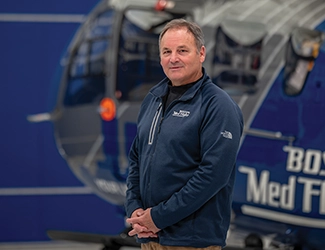
The aviation side of things
Behind the technology are teams who treat each flight as if it were for their own family. Director of Aviation Operations Mark Onorato bridges the gap between aircraft maintenance and flight operations. “The director of maintenance gives us airworthy aircraft. The chief pilots give us qualified, well-trained pilots. And I match the 2 together and oversee the core aviation function for the company,” he explains.
Onorato’s responsibilities extend beyond logistics. He is deeply involved in pilot hiring, scheduling, and ensuring seamless coordination between departments. Whether it’s managing international flights or troubleshooting last-minute scheduling conflicts, his leadership keeps Boston MedFlight’s operations running smoothly.
Boston MedFlight’s pilots are held to the highest standards. The hiring process is a team effort, involving HR and the chief pilots. “We look for things like compatibility, trainability, and qualifications for the job,” says Onorato. Basic requisites include Airline Transport Pilot (ATP) certification and a minimum of 2000 flight hours. EMS experience is a plus, but team fit and adaptability are prioritized.
Onorato continues, “We can teach how to be a good EMS pilot, but we have to select the right individual to be part of the team.” This careful selection process ensures that every pilot can handle the unique demands of medical transport, where they work alongside clinicians to save lives.

Rotary-wing ops
While Boston MedFlight is a non-profit organization, rotary-wing operations are its bread and butter, with more than 50% of total flights being carried out by helicopters. Leading the team is Chief Pilot Nathan Fancher, who has worked in EMS for more than 2 decades, combining his passion for aviation with life-saving missions.
He plays a pivotal role in ensuring that patients across New England receive critical care from the skies. Fancher oversees all aspects of helicopter missions. His role involves hands-on coordination with pilots, ensuring they meet the highest standards of safety and proficiency.
Fancher’s love for aviation began early in his childhood, inspired by family members who worked at Sikorsky. Determined to fly, he pursued his pilot license through grants for flight schools. Soon after earning his initial certifications, he realized that helicopters were his true calling.
His EMS career began unexpectedly. While flying utility missions in the Midwest, Fancher received a note from a fellow pilot, asking if he had ever thought of flying a MBB/Kawasaki BK 117 for EMS. That simple question led him to his first air medical job in Ohio. “I fell in love with helicopter EMS (HEMS),” he recalls. “I love the mission set. I love the schedule.” Twenty-two years later, that passion still drives him.
With 13 years at Boston MedFlight and a deep understanding of both aircraft and team dynamics, his leadership reflects the organization’s commitment to safety, innovation, and community service. His management style is rooted in accessibility. Unlike larger aviation units where pilots may feel like just a number, Boston MedFlight fosters a family-like environment where open communication is encouraged. “You can talk to the managers at any time,” Fancher notes. “Our organization has a great balance between professionalism and personal connection.”
One of Fancher’s key responsibilities is selecting the right pilots for Boston MedFlight’s aviation division. The hiring process is rigorous but designed to assess more than just technical skills. Potential candidates first undergo a virtual interview, which often feels more like a casual conversation than a formal assessment. “While we talk about the job, we may end up talking about cars,” Fancher explains. “This approach helps the team gauge a pilot’s personality and compatibility with our culture at Boston MedFlight.”
Qualified candidates then participate in a ride-along shift, spending a day with a Boston MedFlight crew to experience the job firsthand. Finally, an in-person interview tests their problem-solving abilities with real-world EMS scenarios. Notably, Boston MedFlight doesn’t administer regulatory exams. ”You should know the rules before you come here,” Fancher states.
Over his 13 years at Boston MedFlight, Fancher has witnessed the evolution of the organization’s fleet. He began flying various BK117 models and Sikorsky S-76s, and now oversees a fleet of 7 Airbus H145 D3s, which he considers transformative aircraft for EMS.
The H145’s Helionix avionics system and intuitive autopilot reduce pilot workload significantly, making it ideal for single-pilot IFR missions. “It takes a couple flights to get used to, but it’s very easy to operate,” Fancher explains. “This technology allows pilots to focus on patient care and navigation in the most challenging conditions.”
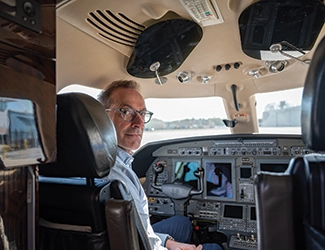
Citation CJ4 missions
F-W Assistant Chief Pilot Christian Rubbert occupies a unique position within Boston MedFlight’s hierarchy. While the organization has separate leaders for rotary-wing and fixed-wing divisions, Rubbert focuses exclusively on the latter, working closely with Onorato and Fancher. His role is multifaceted – part administrator, part mentor, and 100% problem-solver.
Rubbert describes his duties as a mix of general oversight and hands-on management. He oversees pilot scheduling and ensures all training programs meet stringent FAA standards. But his job extends beyond logistics. “I have an open ear for the pilots,” he says. “I’m a bridge between line pilots and upper management.” Whether addressing concerns or implementing new protocols, Rubbert’s approach is rooted in collaboration and efficiency.
Rubbert joined Boston MedFlight 2 years ago. Today, he oversees a team of 3 line pilots and has plans to expand to 6 by June and 8 by the end of the year. This growth is strategic. The current 12-hour shift model often leaves little room for longer missions – especially international flights to Bermuda or Canada, which can take up to 8 hours, because these missions often require intricate coordination with customs and ground teams, especially when delivering patients to major hospitals.
To address this, Rubbert is implementing an overlapping second shift, extending the operational window beyond 18 hours daily. This change will allow Boston MedFlight to capture more transports without sacrificing safety or pilot well-being. “The expansion isn’t just about adding pilots,” explains Rubbert. “It’s about refining a system that balances urgency with sustainability.”
Rubbert’s path to Boston MedFlight reads like an aviation odyssey. Born in Germany and raised in Namibia, he began his career flying bush missions in Africa, landing on dirt roads and improvising solutions in remote areas. After stints in corporate aviation, including 13 years flying Bombardier Global Express jets in Europe and Asia, Rubbert sought a change. When his wife, a New England native, proposed to return home, he stumbled upon Boston MedFlight.
Rubbert’s transition to US EMS was eye-opening. “It’s the first time I’ve worked for a US company, and it’s nothing like I expected,” he admits. “What stood out was the culture of professionalism and support – from the clinical crews’ expertise to the meticulous handling of complex cases.”
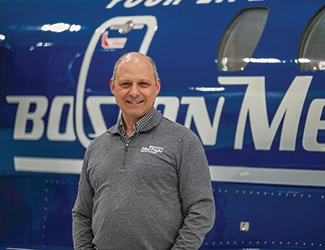
Operations management
From standardizing the fleet to navigating complex financial challenges, COO of Transport Rick Kenin oversees every vehicle in Boston MedFlight’s fleet – 7 helicopters, 1 fixed-wing jet, and 9 ground ambulances. His US Coast Guard-honed expertise and forward-thinking approach have been instrumental in ensuring Boston MedFlight remains at the forefront of airborne medical transport.
However, Kenin’s responsibilities extend far beyond logistics. He also handles aircraft procurement, maintenance, and operations, ensuring each unit meets the highest standards of safety. In addition, he works in tandem with the medical side of the operation to deliver seamless care. “We’re responsible for getting the right patient to the right place at the right time,” Kenin explains. This mantra reflects Boston MedFlight’s mission, which prioritizes patient needs over profit.
Boston MedFlight’s expansion from a single BK 117 helicopter into a regional EMS powerhouse mirrors advancements in medical aviation. Kenin credits much of this success to a shift in 2014, when the organization transitioned from relying on vendor-operated aircraft to obtaining its own Part 135 certificate. “We wanted full control over our operations,” Kenin says. “By 2017, Boston MedFlight achieved this goal. And in 2021, it added fixed-wing capabilities. Today, the organization owns and operates its entire fleet.
One of Kenin’s most significant contributions has been standardizing the helicopter fleet. When he joined in 2014, Boston MedFlight operated 4 different helicopter models, creating maintenance and training complexities. “It wasn’t the safest way to operate,” he admits. Partnering with Airbus Helicopters, Kenin led the transition to an all-H145 D3 fleet, making Boston MedFlight the second US air ambulance provider to adopt the model.
The H145’s advanced avionics and reliability align with the organization’s safety-first ethos. Kenin also implemented a 7–10-year replacement cycle for aircraft, ensuring the fleet remains modern despite heavy use. Medical interiors, customized by Metro Aviation, are identically equipped across all vehicles, allowing clinical staff to transition seamlessly between air and ground units.
Missions range from inter-facility transfers (80%) to scene calls (20%), with a focus on critical care. The team carries specialized equipment like extracorporeal membrane oxygenation (ECMO) machines, intra-aortic balloon pumps, and blood supplies.
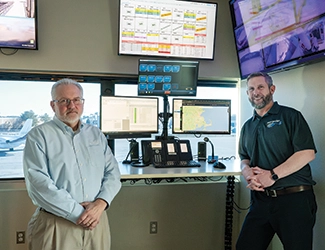
Masters of coordination
Boston MedFlight’s communication center is paramount to every mission. At its helm are Director of Communications Ken Panciocco and Communications Operations Manager John Duggan – 2 seasoned professionals whose expertise ensures seamless coordination between pilots, medical crews, and hospitals across New England.
Duggan’s role as communications operations manager is a balancing act of logistics and leadership. He oversees the communication center’s daily operations, from staffing and equipment maintenance to crafting training programs for new hires.
While he occasionally steps in as a line communicator, his focus is on refining systems to handle Boston MedFlight’s daily transports. “A single air medical call can take hours and involve dozens of phone calls,” he explains. “We’re constantly adapting, ie, switching hospitals, adjusting routes, and ensuring every piece falls into place.”
As director of communications, Panciocco takes a broader view. He manages a team of 18–19 communicators and collaborates with the Northeast Air Alliance (NEAA) – a network of independent regional air medical providers – to deconflict helipad use and streamline regional operations. His approach is rooted in standardization. So much so that he developed processes to ensure calls are handled consistently, whether at 3 pm or 3 am.
Boston MedFlight’s communication center operates like a well-oiled machine. All comm specs are EMT-certified. They triage requests, choosing between helicopter, fixed-wing, or ground critical care transport based on urgency and distance. Once a mode is selected, communicators monitor the mission from takeoff to landing, troubleshooting issues like weather delays or hospital bed shortages in real time.
Panciocco emphasizes the importance of pre-arrival intelligence. “The key is gathering the right details before the team arrives,” he says. “Is security ready? Are there hazards on the roof? A stressed voice on the phone can tell us a lot.” This proactive approach minimizes delays, especially for inter-facility transfers, which make up 80% of Boston MedFlight’s missions.
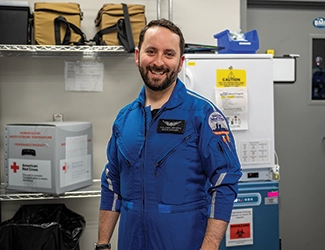
Bridging innovation and critical care
At the intersection of clinical expertise and operational innovation is Critical Care Transport Specialist and Clinical Project Manager Vahé Ender. His role is uniquely split – 50% clinical, 50% project development. In the air, he serves as a critical care paramedic responding to diverse emergencies, such as trauma scenes or neonatal transfers.
“We’re a Swiss Army knife,” he says. “Our helicopters carry everything, from the tiniest endotracheal tubes for neonates to specialized ventilators for ICU-level care.”
On the ground, Ender’s work transforms patient outcomes. He spearheaded Boston MedFlight’s blood transfusion program, enabling teams to administer blood products mid-flight, which is a capability that few air medical services offer.
His projects often begin with identifying gaps in care. For example, he implemented point-of-care blood testing, allowing real-time lab results during transports. “Now we can measure sodium or potassium levels in flight,” he explains. “It’s about bringing Boston’s hospital-level care to the patient’s side, wherever they are.”
Collaboration is key to Ender’s success. He works closely with aviation teams to design helicopter configurations that balance safety with clinical needs. “If I had my way, we’d throw everything onboard, but I’m aware that may not be safe because of weight restrictions,” he says. Instead, he develops standardized equipment mounts and securement systems, ensuring teams can pivot between missions without returning to base.
Education is another cornerstone. Ender designs training curricula for new technologies, like ultrasound-guided arterial lines. He also mentors staff through Boston MedFlight’s committees. “This organization thrives on creativity,” he remarks. “If you have an idea to improve care, they’ll let you run with it.”

Keeping aircraft airworthy
Director of Aviation Maintenance Chris Towne oversees a team of 12 professionals, including 10 aviation maintenance technicians (AMTs), a parts specialist, and a maintenance manager. Together, they ensure Boston MedFlight’s helicopters and jet are mission-ready 24/7.
“Our job is to make sure the aircraft are safe, airworthy, and available whenever they’re needed,” Towne explains. The team’s work ranges from routine line maintenance to heavy inspections that involve disassembling aircraft for thorough evaluations.
One of Towne’s key strategies is proactive parts management. With supply chain delays plaguing the aviation industry since 2020, his team orders critical components months in advance for scheduled inspections. “We don’t wait until the last minute,” he says.
When unexpected issues arise, Boston MedFlight’s spare aircraft serve as backups, ensuring no interruption to patient transports. “If a helicopter goes down on Martha’s Vineyard, we can swap in a spare and get the medical crew back in the air quickly,” he notes.
Technology plays a pivotal role in Towne’s operations. His team uses specialized software that tracks everything from inventory to inspection schedules in real time. “The pilots log their flight hours, and the system updates every component’s status automatically,” he says. This precision is critical for an organization that performs heavy maintenance in-house, including 800-hour inspections, which take 4–6 weeks per aircraft. For the CJ4, Towne relies on Textron tech services and authorized service centers, leveraging warranty programs to minimize downtime.

Overcoming challenges
Operating as a non-profit in a high-cost industry presents unique hurdles. Boston MedFlight relies on hospital consortium support, fundraising, and insurance reimbursements, but Kenin acknowledges the strain of policies like the No Surprises Act.
“Medicare reimbursements don’t cover our costs, and insurers are slow to pay,” he says. Despite this, the organization provides $5 million annually in uncompensated care, refusing to bill patients directly.
Safety challenges are equally daunting, but Boston MedFlight is unique as a small operator in adopting several proven safety elements. Since 2020, it has had an active safety management system (SMS) that extends to both aviation and clinical teams.
Based on the flight data capabilities of the H145 and CJ4, the organization has an approved FOQA program to improve training & standardization. To further mitigate risks, pilots undergo annual simulator training in the US and Finland, and the organization is investing in a VR simulator – the first for H145s in the US – to enhance in-house training.
Conclusion
With a 40-year legacy of accident-free operations, Boston MedFlight stands out as a model of excellence in airborne EMS, blending precision, safety, and teamwork to save lives. Under the leadership of Maura Hughes, Mark Onorato, Nathan Fancher, Christian Rubbert, Rick Kenin, Ken Panciocco, Vahé Ender, and Chris Towne, the organization will continue to innovate – whether through expanding international flights, refining pilot training, or leveraging cutting-edge safety systems.
